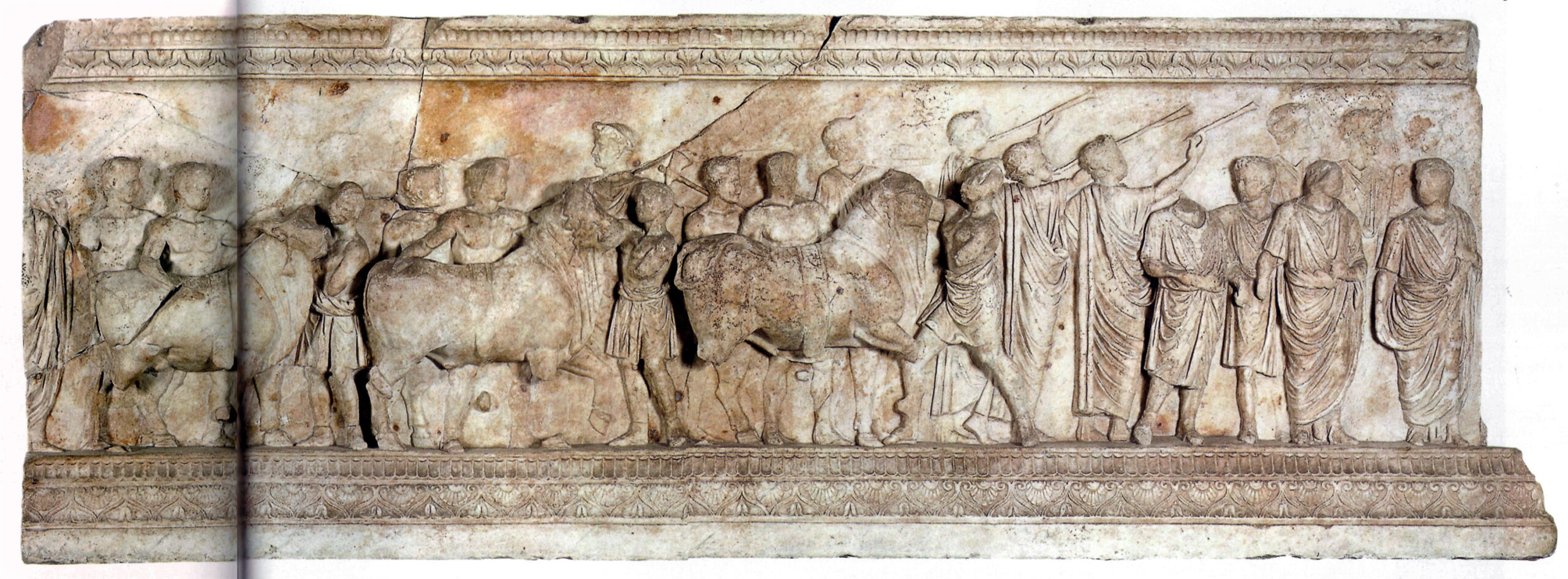Eumenes II’s pompe in Delphi (Eumeneia)
| TITLE: |
| Eumenes II’s pompe in Delphi (Eumeneia) |
| DATE: |
| 160-159 BC |
| TEXT: |
| Syll.3 671 = FD 3.3.238 BRINGMANN, K. and H. VON STEUBEN (1995-2000): Schenkungen hellenistischer Herrscher an griechische Städte und Heiligtümer, 2 vols., Berlin Cf. Sokolowski LSS 44; Laum 1914: no. 29; Daux FD III.3 238 |
| EDITIONS/TRANSLATIONS: |
Syll.3 671 = FD 3.3.238 Collection of Greek Ritual Norms: (English and French : A. JACQUEMIN, D. MULLIEZ and G. ROUGEMONT 2012: Choix d’inscriptions de Delphes, traduites et commentées. Études épigraphiques 5, Athens) |
| KEYWORDS: |
| Word used to mean procession: |
| πομπή or its verbal form πομπεύω (l. 8-9, π[ομ]πευόντω; l. 20, πομπεύσωντι) |
| Word used to mean the cult images: |
| βάσιν (l. 22, βάσις, “base” of the statue) |
| Gods or other entities named: |
| Apollo and Leto and Artemis (l. 5-6, Ἀπόλλωνι καὶ τᾶι Λατοῖ καὶ τᾶι Ἀρτέμιτι; Apollo again in l. 9) |
| Description of the cult images: |
| Procession’s route: |
| From the threshing floor/ from the circular place/”la place circulaire” (A. Jacquemin, D. Mulliez, G. Rougemont 2012, 167) (l. 9, ἐκ τᾶς ἅλωο[ς]). Cf. “The festival was also to include a procession departing from the so-called “Circular Area” (lit. circular “threshing-floor”) in the sanctuary” (vd. J.-M. Carbon and S. Peels) |
| Frequency with which the procession takes place: |
| Every year on the twelfth day of the month of Herakleios (l. 2-3, ἐν τῶι Ἡρακλείωι μηνὶ τᾶ[ι] [δωδεκ]άται), and the procession took place exactly on the twelfth day at the second hour (l. 8-9, τᾶι δωδεκάται π[ομ]πευόντω ὥρας δευτέρας) |
| Performers: |
| The priests of Apollo and of the other gods, the prytaneis, the archons and the other magistracies, and the torch-bearers – ten men from each tribe (l. 9-11, οἵ τε ἱερεῖς τοῦ Ἀπόλλωνος καὶ τῶν ἄλλων θεῶν καὶ οἱ πρυτάνεις καὶ ἄρχοντες καὶ [τ]ὰ ἄλλα ἀρχεῖα καὶ οἱ λαμπαδισταί, ἀφ’ ἑκάστας φυλᾶς ἄνδρες δέκα) |
| References to the public attending the procession: |
| Rites related to the procession: |
The overseers sacrificed three full-grown oxen to Apollo and Leto and Artemis, and they managed the other sacrificial victims according to the instructions, and they used the meat for the public feast, as is customary; and they provided forty metretai of wine (l. 5-8, θυόντω δ[ὲ ο]ἱ ἐπιμεληταὶ βοῦς τρεῖς τελείους τῶι Ἀπόλλωνι καὶ τᾶι Λατοῖ καὶ τᾶι Ἀρτέμιτι, καὶ τὰ λοιπὰ ἱε[ρε]ῖα οἰκονομεόντω κατὰ τὰ διατεταγμένα, καὶ τὰ κρ[έα] καταχρείσθωσαν ἐν τὰν δαμοθοινίαν κα[θ]ὼς εἴθισται· οἴνου δὲ ἀναλισκόντω μετρητὰς τεσ[σα]ράκοντα) There was a race of torch-bearers from the gymnasium to the altar, and the winner set fire to the sacrifice (l. 15-16, ὁ δ[ὲ] δρόμος γινέσθω ἐκ τοῦ γυμνασίου ἄχρι ποτὶ τὸν βωμόν, ὁ δὲ νικέων ὑφαπτέτω τὰ ἱερά), and the tribe that won the torch-race received ten staters of silver for the sacrifice. The priests of Apollo, whenever they go in procession, prayed for the Eumeneia (l. 19-20, οἱ δὲ ἱερεῖς τοῦ Ἀπόλλωνος, ἐπεί κα πομπεύσωντι, κατευχέσθωσαν τὰ Εὐμένεια καθὼς νομίζεται). |
| Allusions to conduct or forms of reverence: |
| Other remarkable elements: |
In this decree the city and sanctuary of Delphi received generous gifts from one its patrons; in this case, Delphi received corn and money in return for holding a festival in honour of Eumenes II (Εὐμένης Βʹ), who ruled between 197 and 159 BC, and surnamed Soter meaning “Savior”; he was a ruler of Pergamon, and a son of Attalus I Soter and queen Apollonis, members of the Attalid dynasty of Pergamon. This dialogue between a city and its benefactor has been interpreted by Domingo Gygax (2016, p. 42) as a “negotiation, (…) he acted as he did partly because Delphi voted to award him great honors – honors that amounted to gifts as well as counter-gifts, and that obliged him to reciprocate”. The councillors in office inscribed this decree on the base of the statue of the king Eumenes II near the altar of Apollo, and they dispatched a copy to the king (l. ἀναγράψαι [δὲ τὸ ψάφισ]μα ἐν τὰν βάσιν τὰν ὑπάρχουσαν τοῦ βασιλέος παρὰ τὸν βωμὸν τοῦ Ἀπόλλωνος τ[οὺς ἐνάρ]χους βουλευτάς, καὶ διαποστεῖλαι ποτὶ [τ]ὸν βασιλῆ τὸ ἀντίγραφον τοῦ ψαφίσματ[ος]) One slightly later decree also studied in this project concerns a donation by Attalos II for the education of boys and honorific ceremonies and sacrifices, also including a procession, a banquet and a torch-race (vd. J.-M. Carbon and S. Peels) Moreover, the Delphic foundation of Alkesippos (also studied in this project), a somewhat earlier document dated to 182 BC apparently served as a partial model for the foundations of the Attaleia and the Eumeneia. |
| BIBLIOGRAPHY: |
BÖMMER (1952), RE: s.v. Pompa. Herrscher, Vol. XXI.2, p. 1967, n.289-293. BOMMELAER, J.-F. and D. LAROCHE (1991): Guide de Delphes. Le site (École française d’Athènes. Sites et Monuments 7), Athens DAUX, G. (1935): “Sur la loi amphictionique de 380 av. J.C.”, RA,pp. 205-219 DAUX, G. (1936): Delphes au IIe et au Ier siècle, depuis l’abaissement de l’Étolie jusqu’à la paix romaine, 191-31 av. J.-C., Paris, pp. 682-685 DOMINGO GYGAX, M. (2016): Benefaction and rewards in the ancient Greek city. The origins of euergetism, Cambridge University Press, Cambridge, p. 42 |
